- Introduction
This article concerns the "Great Siege" of Malta in 1565 by the combined land and sea forces of the Ottoman Empire and the defense of that island by the Knights of St. John, also known as the Knights of Malta. As Christian Masons of the Grand Encampment of Knights Templar, we confer the Masonic Order of Malta just before the Order of the Temple. In that ceremony a brief historical synopsis of the order is presented and reference is made to the siege of Rhodes in 1522, but reference to the possibly more important siege of Malta and its defense by those valiant Knights is missing. This article will attempt to fill in that gap. However, in order to understand more fully the siege of Malta, we need to first consider the siege of Rhodes some forty-three years earlier.
Siege of Rhodes
The Ottoman Turk Sultan, Suleiman, had just attained his victory over Hungary at the siege of Belgrade. The Ottoman Empire had practically mastered the Eastern Mediterranean area. However, one thing impeded its complete domination, namely the garrison of Knights of St. John (Hospitallers) on the Island of Rhodes. Suleiman decided to remove this hindrance by the conquest of Rhodes. The sultan sent two letters to the Grand Master, L'Isle Adam, in essence inviting his complete surrender. In response to the first, L'Isle Adam respectfully declined in view of the order's vow to always defend its possessions. The second, the Grand Master ignored as he improved his defenses. The Sultan countered by declaring war.
The Sultan assembled his fleet of over 700 galleys and an army of more than 200,000 trained troops and sappers (men who burrowed under fortifications and set off explosives). Like most estimates of manpower and materiel cited for ancient battles, these numbers are likely inflated. This formidable host arrived at Rhodes on June 26, 1522. After the armada had sailed past the city in an attempt to strike panic and fear into the hearts of the defenders, a remote area was chosen for disembarkation. It took almost two weeks to unload the army, the supplies, and the armaments.
The defense of Rhodes was entrusted to about 500 Knights and their men of arms, with approximately 1,500 mercenaries and perhaps 4,000 native Rhodian troops. There were several thousand inhabitants of Rhodes, who when the Turks arrived entered the walled city for protection. Few of these had any military training, and many were women and children. However, these noncombatants could aid by helping rebuild the walls, carrying water, delivering supplies, and performing other essential support tasks. The city was strong, surrounded by a double wall with thirteen towers, plentiful bastions, special fortifications, and a deep wide trench around all, and the entire area was commanded by cannon positioned to provide both frontal assault defense and crossfire.
In the early days of the siege, the Turks suffered great losses due to the weaponry and stout resolution of the defenders. So heavy were the losses that the invaders talked of abandoning the siege. However, the Turks had failed in the past to subdue Rhodes, and this time, determined not to fail, the Sultan himself arrived on July 28th to command the siege. The battle raged day and night for five months. During the day the walls would be battered into rubble, while combat occurred all around the city as thousands of Turks assaulted various fortified positions. Then, during the night, even during bombardment, the walls were rebuilt. Buildings throughout the city would be torn down and the stone used to rebuild the fortifications.
The battle continued, with fanatical bravery and heroism on both sides, attended by almost unthinkable carnage. But the prolonged siege took its toll. By mid-December, only a few Knights were still alive. Tens of thousands of Turks were dead. The stench of rotting bodies of men and animals hung all over the island. Unsanitary conditions contributed to rampant disease. The suffering and dying of the thousands of wounded was almost unbearable. Finally, with winter approaching, the Sultan offered a truce. He had no idea how many Knights remained, and if a considerable number were still alive, and if they continued to fight as they had done, the siege would be too costly for him to continue. Similarly, the Grand Master, de L'Isle Adam, was faced with rebellion by the civilian Rhodians and Greek citizens and demands by the clergy for a truce. With few Knights still able to resist, he agreed to negotiations. The truce was signed on December 20th.
Filled with awe for the Knights, and in contradistinction to the usual cruel Muslim behavior, Suleiman was magnanimous. In return for the surrender of Rhodes, the Sultan promised that the churches would not be desecrated, the citizenry would not be molested or enslaved, any residents of Rhodes who so desired would be free to leave the island with the Knights, those remaining would pay no tribute for five years, and the Knights could depart in their own galleys and be supplied by the Turks with additional ships if needed. In addition, the order could depart with all its property, relics, consecrated vessels, and records on board its warships. Suleiman himself came into the city on December 26th to salute the Grand Master and addressed him by the respectful title of "Father." On the first day of January 1523, L'Isle Adam and some 180 intrepid Knights put to sea on fifty ships loaded with the order's property together with all those who had fought alongside the order and all Christians who had opted to accompany them. However, the memory of this siege persisted in the mind of both Turk and Knight and would be remembered by both sides forty-three years later at Malta.
From Rhodes to Malta -- 1523 - 1530
As the historical lecture in our Order of Malta tells us, "During the period from 1523 to 1530 the order ceased to exist as a sovereign power, and the remnants of it wandered from place to place without a home. They went first to Castro in the Island of Candia (Crete), thence successively to Venice, Viturbo, Villa Franca, Syracuse, and Messina. On the 24th of March, 1530, the Emperor Charles V ceded the Island of Malta to the order, on condition they would defend it and repress the ravages of the Moorish rovers. Accordingly, under L'Isle Adam, the then Grand Master, they took possession of the Island and thenceforth acquired the additional title of "Knights of Malta."
Malta and Its Geography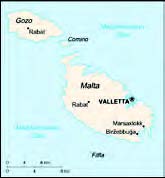
To understand why Malta was so important and how the Great Siege was carried out, we need to consider something about Malta's geography. Malta is an archipelago located in the Mediterranean Sea approximately 93 km (58 miles) south of Sicily, Italy and nearly 300 km (188 miles) north of Africa. Only the three largest islands; Malta, Gozo, and Comino; are inhabited. The country is approximately 316 square kilometers (125 square miles) in area. By comparison, the area occupied by Malta is slightly less than twice the size of Washington, D.C.
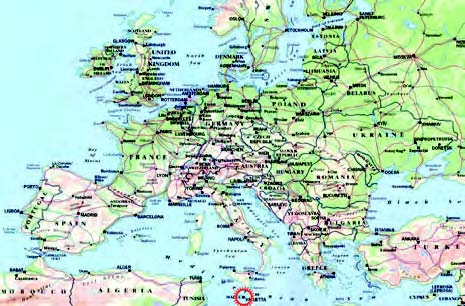
Numerous bays along the indented coastline of the islands provide good harbors. The landscape of the islands is characterized by high hills with terraced fields. The present capital is Valletta. Phoenician traders who settled Malta called it Maleth, meaning "haven." The Greeks corrupted the name to Melita, meaning "honey," from which the name Malta is derived.
From its location, Malta was the key to the control of the Western Mediterranean Sea in the 16th century, a fact of which the Turks were acutely aware. The Knights of St. John quartered on Malta possessed galleys and manpower to harass and limit the predations of the corsairs of the North African coast (vassals of the Sultan) and to thwart the Sultan's grand ambition to make the entire Mediterranean an Ottoman lake. By 1565, Suleiman had decided that Malta must be taken and that the power of Knights of St. John, that "nest of vipers," must be decisively broken.
The Opponents in the Drama
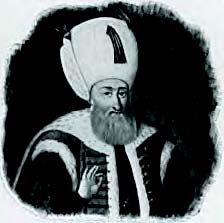
Suleiman the Magnificent
The Sultan, Suleiman I(1494-1566) became a prominent monarch of 16th century Europe, presiding over the apex of the Ottoman Empire's military, political, and economic power. He also became a great patron of culture, overseeing the golden age of the Ottoman Empire's artistic, literary, and architectural development. In the West, he was referred to as "Suleiman the Magnificent." He was a formidable warrior as well. In August of 1526, he defeated the Hungarian army at the Battle of Mohàcs. The Ottoman Empire thus became the pre-eminent power in Eastern Europe. Under Charles V and his brother Ferdinand, Archduke of Austria, the Habsburgs reoccupied Buda and took Hungary. As a result, in 1529, Suleiman once again marched through the valley of the Danube and regained control of Buda and in the following autumn, laid siege to Vienna. It was to be the Ottoman Empire's most ambitious expedition and the high point of its drive towards the West. With a reinforced garrison of 16,000 men, the Austrians inflicted upon Suleiman his first defeat, sowing the seeds of a bitter Ottoman-Habsburg rivalry that lasted until the 20th century. On September 6, 1566, Suleiman, who had set out from Constantinople to command an expedition to Hungary, died prior to an Ottoman victory at the Battle of Szigetvár in Hungary.
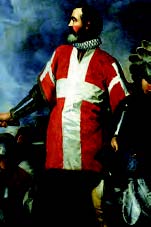
Jean Parisot de La Valette
The Grand Master of the Knights of St. John, Jean Parisot de La Valette (1494-1568), was the 48th Grand Master of the order, elected in 1557. When still young he entered the Order of St. John as a Knight of the region of Provence in France. He had witnessed the siege of Rhodes. He ardently devoted himself to fighting the Moslems. Thanks to La Valette's fearless leadership, the galleys of the order were able to save several Christian ships and to capture many corsairs. At his own private expense, La Valette had two galleys built, and the wealthier commanders followed his example. The vessels of the order were commanded by experienced navigators who knew all the ports and even the smallest bays of the Mediterranean. This naval crusading strength soon made itself feared by the Moors of Barbary and even by the Turks. Before long, the Maltese squadron gained a bloody victory between the islands of Zante and Cephalonia and captured a Turkish galleon manned by two hundred janissaries and laden with precious merchandise, and within five years they had taken fifty Turkish vessels.
Accounts of the Siege
Most historical accounts of the Siege draw on the diary kept by Francisco Balbi de Correggio (1505-1589) who served as an arquebusier with the Spanish contingent during the Siege. In 1567 he published the diary in Alcala de Henares, Spain. It proved so popular that a second printing was done in 1568 in Barcelona. Balbi's is the best-known eyewitness account of the siege (there is at least one other, in the form of a long poem by the Knight Hipolito Sans), and all subsequent histories rely heavily upon it. (For those interested in reading its translation, book reference number 1 is an excellent translation.)
| [Part 1:] | [Part 2:] | [Part 3:] |
- Both Sides Prepare for the Siege
The deciding factors leading to the Siege of Malta were the capture in mid-1564 in separate incidents of the governors of Cairo and Alexandria as well as the 107-year old former nurse of Suleiman's daughter (returning from Mecca) by the order's galleys cruising the Eastern Mediterranean. These captives were worth considerable ransom. The sultan's court and subjects cried out for revenge. Not only this, but he was informed by spies of the order's plans to erect new massive fortifications within their secure harbor. The experience at Rhodes taught him that if this was allowed to happen, it would be extremely difficult, if not impossible, to conquer and expel the Knights. At a meeting of the divan in October 1564, Suleiman made the decision to attack Malta. In November he named Mustapha Pasha as commander of the campaign and Piyale Pasha as admiral of the imperial navy, both seasoned campaigners. Due to past reconnaissance, the Ottoman high command was keenly aware of the topography of Malta as well as the situation of the Knights and their fortifications. One major drawback was the distance to Malta from supply sources-almost a thousand miles. The invading army must carry with it sufficient food, shelter, timber, naval stores, and materials for a siege. They could rely only on limited support from the corsairs of North Africa. Timing was essential; there was a window of opportunity of but a few months. However, at campaign planning and arranging for logistical support, the central Ottoman government was unsurpassed (Crowley 87,90-91).
Shipbuilding, armaments, and provisions were undertaken at a grueling pace. Although it was clear that the Turks were preparing for war, European observers and spies were uncertain as to the objective. Malta was guessed, but so were other locations. In December, Suleiman decided against going himself. His proxy would be Mustapha Pasha. Also summoned from Tripoli was Turgut Reis (also known as Dragut), a corsair with extensive knowledge of the island who would help and advise Mustapha and Piyale. This division of command would later cause difficulty during the campaign. On March 30, 1565, the armada set sail from Istanbul amid much fanfare. The Ottoman fleet consisted of nearly 200 ships, mostly galleys. It carried about 30,000 troops not counting the galley slaves or the sailors on the ships. Of those troops, 6,300 were part of the elite Janissary Corps of musketeers. During the course of the siege, at least 10,000 additional troops from Egypt and the other Islamic lands of North Africa would join the Ottoman army (Crowley 95-96).
Because of the uncertainty of the Turkish objective or due to hesitation on La Valette's part, it was not until January 1565, that the 70-year old Grand Master began taking action. This resulted in last-minute preparations for the island's defense. 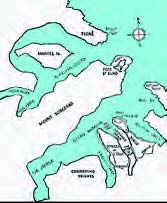
The key to Malta was the fine natural harbor on the eastern side of the island that extended four miles inland with several sheltered anchorages. Two adjacent necks of land jutted into the harbor, and it is on these peninsulas that the Knights had established their strongholds. On one of these was the town of Birgu which was protected by Fort St. Angelo commanding the water. The other promontory, Senglea, was separated from Birgu by a 300-yard wide inlet that was guarded by Fort St. Michael. Within this inlet the Knights kept their galleys. The town and Fort St. Michael were connected by a pontoon bridge and a chain could close the mouth of the inlet. In 1565 neither peninsula had complete fortifications on their landward sides (Crowley 99-100).
Across the water from these peninsulas was a much higher peninsula named Mount Sciberras, which was the key to the whole harbor. Unfortunately, its only protective structure was a small, hastily constructed, star-shaped fort called St. Elmo.
All three strongholds were unfinished and required urgent attention to withstand an Ottoman assault. In the early months of 1565, much was necessary to do.
To augment the defending force of some 600 Knights, in January, La Valette began trying to hire mercenaries as well as Spanish and Italian troops. Due to bureaucratic and logistical complications, in the end few of them arrived in time. The other source of men was the Maltese militia, for whom La Valette had little regard as soldiers. In the end, the Maltese provided the bulk of the fighting men and proved to be skillful and reliable troops. Also undertaken was a crash effort to procure adequate supplies of food and materials as well as forcibly evacuating noncombatants to Sicily. In the spring of 1565, La Valette's military force of 8,000 to 9,000 included his Knights, the army of Maltese irregulars, and other troops from Sicily. La Valette garrisoned isolated St. Elmo with fifty-two Knights and 800 additional troops including 200 Spanish soldiers from Sicily.
The Assault on Fort St. Elmo
On May 18, observers at St. Elmo and St. Angelo sighted the arrival of the Ottoman fleet. The alarm was sounded and all the inhabitants of Malta took refuge in the fortified towns. Most Maltese went to Mdina, the ancient capital of the island, located inland about nine miles north of the harbor. It was a fortified medieval citadel, but its fortifications were old-fashioned and vulnerable to cannon. To reassure the nervous local population, detachments of soldiers had been sent to the town, and the Knights' cavalry was stationed there in order to carry out raids. The locals nearer the harbor crowded into St. Elmo, Birgu, or Senglea (Crowley 105,106).
The Ottomans began landing at the southern bay named Marsasirocco on May 19, confident they would easily conquer Malta in less than two weeks. Moving on Birgu, they assaulted its walls on May 21, which resulted in the death of twenty-one defenders and several hundred Turks. This initial encounter did reveal that the Turkish musket fire was more accurate than that of the Europeans due to the better weapons of the Turks. Admiral Piyale demanded that the first objective be St. Elmo so that he could have use of the safer Marsamuscetto harbor, on the Northwest side of Mt. Sciberras. Mustapha Pasha did not agree. He wanted to capture Mdina and focus on Birgu, but he grudgingly yielded to Piyale, who argued that the safety of the fleet was paramount.
Dragging cannons up to Mt. Sciberras, the Ottomans began bombarding St. Elmo on May 27. They expected that it would fall within a week. La Valette considered St. Elmo the key to Malta's defense. Throughout the Turkish assaults, he continually reinforced St. Elmo by sending soldiers across the harbor in boats. The decision not to capture Mdina was a big mistake on the part of the Ottoman commanders. La Valette's cavalry force continually harassed the Turks from the rear, a tactic that would eventually prove very fruitful for the defenders.
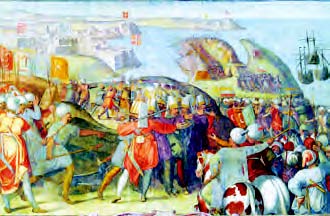
Turks Land on Malta
To attack St. Elmo, the Turkish troops had to cross a moat under fire. The defenders had raised drawbridges and broken down other bridges so the Turks had to construct portable bridges. Such massed attacks were costly in terms of casualties. Furious attacks continued through May 29th with tremendous casualties among the Turks, although La Valette had to continually reinforce the garrison at St. Elmo with fresh troops. Dragut, arriving shortly after May 29, regarded the focus on St. Elmo to be a mistake. However, he also thought that since they were committed, the Ottomans could not abandon the attack and would have to continue until St. Elmo fell. Trained as an artilleryman by the Mamelukes of Egypt, Dragut brought increased order to the Turkish bombardment. He added batteries at Dragut Point and Gallows Point to bring fire on St. Elmo from all directions. Soon the Turks were firing about 7,000 rounds into St. Elmo every day. The fort was slowly being pulverized.
With summer at hand, the temperatures began to climb, providing an unexpected and ominous ally for the defenders. The hot sun and warm air ripened the unburied dead and bred disease, while the water sources poisoned in early spring by order of La Valette gave rise to dysentery in the Turkish camp.
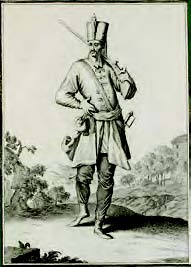
Janissary
The attacks on St. Elmo continued with fierce assaults spearheaded by the elite Ottoman troops known as Janissaries on June 3 and June 7. They possessed expertise in use of the arquebus (an early portable gun with a long barrel, supported on a tripod by a hook or on a forked post). The defenders however, wreaked havoc among the Turkish attackers. Despite their success, some of the younger Knights in St. Elmo demanded on June 8 that the fort be evacuated. Instead, they were shamed into staying the course. Its garrison, aware that the length of their survival would determine the outcome of the whole campaign, hung on as men died and walls collapsed under day and night bombardment. An intense night assault on June 10 killed sixty defenders, but also resulted in 1,500 deaths among the Janissaries. The cannons of St. Angelo were used to support the defenders of St. Elmo with enfilading fire.
On June 18 the Ottomans suffered two stunning and decisive blows. The first came when shrapnel from a poorly aimed Turkish cannonball mortally wounded Dragut as it struck him beneath the ear. Only his thick turban prevented instant death, but the head wound put him out of action and eventually killed him a few days later. Another piece killed the Master General of the Turkish ordnance outright; he was the second in command of the army under Mustapha Pasha. The second blow came when artillery fire from the defenders killed the commander of the Janissaries.
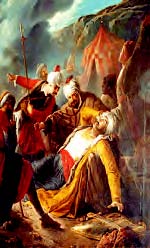
Death of Dragut
Another furious assault on June 22 resulted in 2,000 more Turkish casualties, but the war of attrition was decisively favoring the attackers. It was clear that St. Elmo was doomed. Turkish troops breached the walls, and on June 23, the eve of the feast-day of St. John the Baptist, a Turkish assault overran the fort. Nine Knights were captured by Dragut's men, never to be seen again and probably died as galley slaves. Five Maltese swam to safety, but the rest of the garrison perished with no quarter given. "Mustapha had some of the bodies of the Knights…, mutilated and dressed in their distinctive red and white surcoats and nailed to crosses…launched into the water off St. Elmo's point, where the current washed them across to Birgu. La Valette retaliated by taking all the Turkish prisoners out of the dungeons and slaughtering them on the ramparts (Crowley 140)." In the course of the month-long siege of St. Elmo, the Turks lost 8,000 men, roughly a quarter of their troops, including many elite Janissaries. About 1,500 defenders had died. Two hours after St. Elmo's fall, Dragut "drank the sherbet of martyrdom and forgot this vain world." (Crowley 141). As Mustapha Pasha looked from the ruins of captured St. Elmo across the Grand Harbor to the fort of St. Angelo, he asked, "Great Allah! If so small a son has cost us so dear, what price shall we have to pay for so large a father?" The small fort had fallen, but it had bought precious time for improving the fortifications and defenses of Birgu and Senglea.
| [Part 1:] | [Part 2:] | [Part 3:] |
- Senglea and Birgu under Attack and Siege
On the same day that St. Elmo fell, the defenders received an important boost. Another 42 knights along with a force of soldiers from Sicily totaling 700 men landed on Malta and managed to sneak past the Turkish lines to reinforce Birgu by crossing Kalkara Creek on the Northeast side of the city. Meanwhile, hoping to avoid more bloodshed, Mustapha Pasha offered the Knights honorable terms of surrender. La Valette refused, remembering that the low morale of the townspeople had been a crucial factor in Rhodes in 1522. Any hint of negotiation could lessen resolve. Mustapha began setting up his cannon to bombard Birgu and Senglea. His plan was to attack the fort of St. Michael at Senglea first. The westward side of Senglea, which could be easily bombarded from the shore, had no serious fortifications. If Mustapha could find a naval way of attacking the westward side, Senglea would soon be his. He had further decided that all Christians would be killed except La Valette, and he would be taken to the Sultan in chains.
From July 6 to July 14 Mustapha had a total of 80 ships drug over greased rollers by oxen 1000 yards across the peninsula of Mount Sciberras to threaten the defenders of fort St. Michael while bypassing the guns of St. Angelo, but a deserter from the Turkish army had informed La Valette of the Turkish plan to attack across the water. La Valette accordingly caused a pontoon bridge of airtight barrels to be assembled that could be used to transfer troops quickly from Birgu to Senglea. In addition, his Maltese shipwrights conceived the idea of driving a long line of stakes into the seabed about a dozen paces from shore with a chain passing through iron hoops attached to each. This would provide a defensive barrier stretching along the entire western shore of Senglea and stop an amphibious landing (Crowley 149).
As dawn broke on the morning of July 15, boats with multicolored pennants and packed with men approached the shore. The shore guns opened up and ripped through the fleet, killing many. The Ottoman forces attacked both the landward walls and the Spur at the tip of the Senglea promontory. Fierce fighting ensued with both sides engaged in close combat. During the heaviest part of the engagement, Mustapha launched ten large boats with about 1,000 janissaries and marines, which headed around the tip of the Spur to a section where there were no defenses and extremely low ramparts. Two hundred yards away was the tip of the second peninsula of Birgu. Unknown to the Ottomans, however, the defenders on Birgu had a concealed gun battery, almost at water level. The commander carefully loaded his five cannon with grapeshot, stones, chain pieces and spiked iron balls, and waited (Crowley 153,154). This well-prepared trap caught the Turks totally by surprise and destroyed them. Next, the arrival of a group of Maltese Christians crying "Relief! Victory!" caught a Turkish rear post unawares. Word spread through the Turkish forces that a large army from Sicily was about to attack, and the commander, believing himself outnumbered, sounded the retreat. However, this supposed van of the Christian battalions was merely a local force from Mdina that had come along to see if it could help. Panic ensued among the Turks, and they left off the attack and waded into the water, trying to reach the few remaining landing boats near the shore which were overturned in the process. Seizing the opportunity, the defenders rushed onto the beach, stabbing and shooting the disorganized and confused Ottoman soldiers. Some of these threw down their weapons and begged for mercy, but St. Elmo was still fresh in Christian minds, and no mercy was shown. "Four thousand dead lay sprawled at the walls and drifted gently in the sea. Bodies washed up on the shore for days." (Crowley 154, 155)
As Malta was being besieged, messengers were furtively crossing by small boats from the island to Sicily carrying coded messages to Christian Europe. Some messengers made it; others were caught by Ottoman patrol ships. In return, some few Knights of St. John from other outposts as well as various soldiers of fortune headed for Sicily to join the rescue attempt. But vacillation and delay on the part of European royalty, particularly King Philip II of Spain, stalled progress in forming and transporting a relief force.
Because of the disaster of July 15, Mustapha decided to attack both Senglea and Birgu by the means that had been employed on St. Elmo. He would now subject both to heavy bombardment, trenching operations, and surprise attacks. He would concentrate his efforts on the short land fronts of both peninsulas simultaneously. At dawn on July 22, from the heights above the harbor, sixty-four guns in fourteen batteries pounded the defenses of Birgu and Senglea. The people in Sicily, 120 miles to the north, could hear the rumble of this cannonade. The Turks attempted to enter Senglea by the use of two huge towers but were successfully repulsed by the Knights. La Valette exhorted the besieged to be courageous, and during the most ferocious stage of the battle crossed over from St. Angelo to join in the battle.
For the first time in the siege, the Turks were driving mines beneath the defenses. At St. Elmo they had been unable to do so because of the hard rock on which the fort was built, but the soil of Birgu was more pliable. It had been mining that had won for the Turks at Rhodes, and they now attempted to repeat their success. This was a task of extreme difficulty, and even the specially trained Egyptian engineers found themselves faced with an almost insuperable problem. The soil of Malta lies six feet deep at most, with sand and limestone beneath; when quarried this could be cut quite easily, but it was incredibly difficult to tunnel through at short notice. While the sappers worked underneath, the batteries continued to harass the Christian defenses from Mt. Salvatore and the far side of Kalkara Creek. The sappers labored mightily to dig tunnels under the walls of Birgu in order to fill them with gunpowder and thus destroy or undermine the fortifications. On August 18 a mine exploded under one of the walls and it partially collapsed, and the Ottomans launched a coordinated attack on both Senglea and Birgu. They penetrated into Birgu but were successfully repulsed by troops led by a slightly wounded La Valette who retook the breached wall. "Withdraw, Sire, to a place of safety!" shouted one of his staff during the conflict. "The enemy is already in retreat!" Although this was true, the Turks still occupied the breach. La Valette knew his presence alone had put new heart into the garrison, and now was not the time to forsake his men. Limping, he went forward up the slope. "As long as their banners still wave in the wind," he said, "I will not withdraw."
The Turks also erected more large siege towers to threaten the walls of Birgu. La Valette's nephew was killed attempting to destroy a Turkish siege tower on August 18. Although the tower survived that day, the Knights destroyed it soon after. A cannon was run out and fired chain-shot, which consisted of two large cannon balls fastened together by chain. Immediately on leaving the cannon's mouth, the chain-shot whirled in an arc, acting like a giant scythe. At point blank range, this whirling chain sliced, ground up, and pounded the wooden structure. The tower sagged and buckled as the Turks leapt from its heights. Finally, it collapsed in a wrecked heap with a thunderous crash, spilling men, arms, ammunition, pitchers of water, and incendiary grenades in all directions. The cannon was returned back inside the fortress, and a Maltese work party immediately started to restore the outer wall. As they watched the giant tower be set on fire, the Ottoman leaders were almost despondent. It was becoming more and more difficult to induce their men to attack, sickness was spreading, and ammunition and provisions were beginning to run low. Their will to fight was dampened by their numerous losses. The next day, August 20, the Knights even managed to capture another Turkish tower. Manned by Janissary snipers, the base of the tower had been reinforced with earth and stonework to forestall a repetition of previous events. These snipers began to pick off the remaining defenders on the other side of the ruined walls, and as they began to falter, La Valette realized that if the tower were to remain there, keeping the garrison pinned down, a further frontal assault would almost inevitably succeed.
As before, he ordered the Maltese workmen to open a way through the wall at the base at a point where they could not be seen by the Janissary snipers. The moment that the last blocks fell away, a raiding party made straight for the tower. Never expecting that the defenders would venture outside the walls-and prepared for cannon shot only, the Turks were taken completely by surprise. Scaling the tower with the stone base giving them easy access to the lower reaches, the soldiers mounted the laddered floors, killing the Janissaries as they progressed. The Christians then turned this tower into an observation post and furnished it with their snipers.
Desperation was present on both sides. Mustapha's dark mood deepened when he learned that a large store ship coming from North Africa to replenish their diminishing supplies had been captured by a Christian galley. The Ottomans were running low on gunpowder, evident to the defenders of Malta, who observed the cannonade from the Turks subside significantly. Inside Birgu, the Grand Council of the Knights urged La Valette to abandon Birgu and retreat to St. Angelo. He refused because he believed this would mean total defeat soon after. Meanwhile, Mustapha ordered the capture of Mdina, but that effort was forsaken in the face of strong resistance by the garrison inside the town.
What of the expected reinforcements for the besieged? From the beginning of the siege, La Valette and the Knights had hoped for European aid from Sicily. The Spanish Viceroy of Sicily, Don Garcia de Toledo, had promised to send an army in June and then July, but both times it failed to appear. Finally, on August 25, a Spanish fleet with 8,000 to 10,000 soldiers sailed from Syracuse for Malta. However, a storm delayed and damaged it. The fleet returned to Sicily and did not sail again until September 4.
On September 1, the Turks attempted one last all-out assault which ended in failure. The fighting forces of Mustapha and Piyale were getting dreadfully mauled with the remaining troop strength down to about 15,000 men.
Relief Arrives at Last
On September 7, the long-awaited Spanish force from Sicily finally arrived, comprised of about 8,000 men. In order to deceive the Turks, La Valette sent double agents into the Turkish camp to spread the word that twice that number had landed. As a result, Mustapha ordered an evacuation on September 8. However, Turkish scout ships sent word of the small relief fleet, and Mustapha ordered the troops already on board to disembark, but Piyale countermanded his order. Disagreement between the two commanders had become a common occurrence. Thus, about 9,000 Turks were onshore to face the 8,000 men of the relief force. The troops from Sicily, disappointed not to have been able to fight for the faith, now bore down upon the Moslems. They engaged in fierce battle, slaughtering 3,000 of Mustapha's army and drove the remainder to sea. Thus, the Ottomans were turned back, and they retreated, boarded their ships in an orderly manner, and set sail for Constantinople.
The Aftermath of the Siege
The Great Siege was over, having lasted four extremely costly months. The Grand Master and his council now took the time to take stock of what had befallen them. 7,000 Christian soldiers and Maltese had died defending the island, including 250 of the Knights. Although the garrison consisted of 9,000 men at the beginning of battle, only 600 remained capable of bearing arms at its end.
The Turks had lost approximately 15,000 men. Mustapha Pasha and Piyale likely trembled for their lives when they returned in defeat to Constantinople. Suleiman's rage was terrible, but he spared their lives. "There is not one of my officers whom I can trust!" he cried. "Next year, I myself, the Sultan Suleiman, will lead an expedition against this accursed island. I will not spare one single inhabitant....! I see that it is only in my own hand that my sword is invincible." The expedition did not take place, and in the following year he turned his attention to the war in Hungary where he died in 1556 at the age of 72. In the course of a long reign, perhaps the most glorious period in the history of Islam, he had only met with two defeats. The one was his failure before the walls of Vienna in 1529, and the second-and by far the most damaging-was at Malta. This was the last formal attempt made by any leader of the Ottoman Empire to break into the western Mediterranean, and it was the defeat of his army in this great siege that first checked the westward expansion of Turkish power.
The tenacity and heroic action of La Valette during the Great Siege caused him to become greatly admired. Afterward, all the princes of Europe sent their congratulations; the pope offered him a cardinal's hat (which he refused); 300 noblemen came and offered him their services. To protect the island from any future attack, the Grand Master had another town built in 1566 upon the site of the Fort St. Elmo ruins. This was the city of Valette (or Valletta) which made Malta virtually impregnable. The last years of La Valette's life were saddened by disputes with the pope, but at the time of his death, in his seventy-fourth year, he was busy preparing "for some great deed of war and of conquest." La Valette died on August 21, 1568. In his final request, he appealed to his brethren to live together in peace and unity and to uphold the ideals of the order.
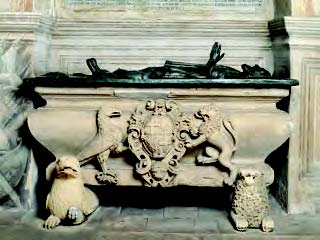
ValetteTomb
He now lies in the great crypt of the Cathedral of St. John. The inscription upon La Valette's tomb, composed in Latin reads:
"Here lies La Valette, worthy of eternal honor. He who was once the scourge of Africa and Asia and the shield of Europe,whence he expelled the barbarians by his holy arms is the first to be buried in this beloved city, whose founder he was."
Sources and References Used
Internet:
1. http://www.dailymail.co.uk/news/article-466818/Historys-bloodiest-siege-used-human-heads-cannonballs.html
2. http://greatsiege.com.mt/index.pl/francesco-balbi
3. http://greatsiege.com.mt/index.pl/history
4. http://greatsiege.com.mt/index.pl/malta
5. http://www.pynchon.pomona.edu/v/siege.html
6. http://www.storialibera.it/epoca_moderna/turchi_ed_europa/assedio_di_malta_1565/articolo.php?id=291&titolo=Malta%20of%20the%20Knights
7. http://www.corndancer.com/fritze/fritze_020039/fritze028.html
8. http://en.wikipedia.org/wiki/Jean_Parisot_de_la_Valette
9. http://en.wikipedia.org/wiki/Suleiman_the_Magnificent
10. http://en.wikipedia.org/wiki/Siege_of_Rhodes_(1522)
11. http://www.osjknights.com/historyp.htm
12.http://www.newadvent.org/cathen/09047a.htm
Books:
1. Ernie Bradford, Great Siege: Malta 1565, Wordsworth Military Library, Hertfordshire, Great Britain, June, 1999, ISBN-13: 978-1840222067
2. Crowley, Roger, Empires of the Sea: The Siege of Malta, the Battle of Lepanto, and the Contest for the Center of the World, Random House Trade Paperbacks, New York, May, 2009. ISBN-13: 978-0812977646 (A substantial part of this article used in the Siege description was paraphrased or quoted from this book and was used by Mr. Crowley's kind permission. Page references in the book are shown.)
3. Seward, Desmond, The Monks of War: The Military Religious Orders, Penguin Books, London, March, 1996, ISBN-13: 978-0140195019
4. Heathcoate, John, Malta, the Crusades and the Knights of the Order of St John of Jerusalem, Melrose Books, Ely, Cambridgeshire, Great Britain, August, 2008, ISBN-13: 978-1906050825
5. Sire, H.J.A., The Knights of Malta, Yale University Press, New Haven, CT, September, 1996, ISBN-13: 978-0300068856
6. Clot, Andre, Suleiman the Magnificent, Saqi Books, London, November, 2004, ISBN-13: 978-0863565106
7. Reston, James, Jr., Defenders of the Faith: Charles V, Suleyman the Magnificent, and the Battle for Europe, 1520-1536, Penguin Press, May, 2009, ISBN-10: 1594202257
8. Grand Encampment of Knights Templar of the United States of America, Ritual of the Orders of the Red Cross, Malta, and the Temple.
Other:
1. Crowley, Roger, Private e-mail communication, May 14, 2011
Sir Knight Marshall is a Past Grand Commander and Past Grand High Priest of Alabama and serves as an Aide-de-Camp to the Grand Master of the Grand Encampment. He is a member of the Editorial Review Board of the Knight Templar magazine. He is also a Knight Commander of the Temple of the Grand Encampment and has published articles in the Royal Arch Mason, Knight Templar, and Philalethes magazines. He resides at 161 Anna Kathryn Drive, Gurley, AL 35748 and can be reached at: geomarsh@yahoo.com